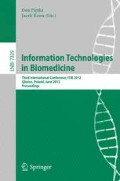Abstract
It is described a concept of an algorithm of similar sequences of samples detection in groups of long biomedical time-processes. The concept is based on the properties of a similarity measure. The method is based on the operations of splitting the process into sections and/or subsections, assessment the similarities between selected pairs of sections and on collection of similar sections into similarity groups. Calculation costs reduction by selection of jointly admissible pairs of sections of the analyzed process is proposed. A possibility to extend the approach on streaming processes is shortly described. Basic points of the method are illustrated by numerical examples.
Access this chapter
Tax calculation will be finalised at checkout
Purchases are for personal use only
Preview
Unable to display preview. Download preview PDF.
References
Pawlicki, G.: Backgrounds of medical engineering. OW Pol. Warszawskiej, Warsaw (1997) (in Polish: Podstawy inżynierii medycznej)
Kozlov, E.A., Gogonenkov, G.N., Lerner, B.L., et al.: Digital processing of seismic data. Nedra, Moscow (1973) (in Russian: Ciffrovaya obrabotka sejsmičeskich dannych)
Kurzyński, M.: Objects recognition. Statistical methods. OW Pol. Wrocławskiej, Wroclaw (1997) (in Polish: Rozpoznawanie obiektów. Metody statystyczne)
Stąpor, K.: Automatic objects recognition. AOW EXIT, Warsaw (2005)
Deonier, R.C., Tavaré, S., Waterman, M.S.: Computational Genome Analysis. An Introduction. Springer, New York (2005)
Baxevanis, A.D., Ouellette, B.F.F. (eds.): Bioinformatics. A Practical Guide to Analysis of Genes and Proteins. John Wiley & Sons Inc. (2001)
Polanski, A., Kimmel, M.: Bioinformatics. Springer, Berlin (2007)
Kulikowski, J.L.: Objects’ Matching Recognition Problem and Its Applications. In: Ramakrishnan, S., El Emary, I.M.M. (eds.) Computational Techniques and Algorithms for Image Processing, pp. 81–105. LAP Lambert Academic Publishing, Saarbrücken (2010)
Tung, A.K., Zhang, R., Koudas, N., Ooi, B.C.: Similarity Search: A Matching-based Approach. In: Proc. of VLDB, Seoul, pp. 631–642 (2006)
Kontaki, M., Papadopoulos, A.N., Manolopoulos, Y.: Similarity Search in Time Series Databases. In: Rivero, L.C., Doorn, J.H., Ferraggine, V.E. (eds.) Encyclopedia of Database Technologies and Applications, pp. 646–651. Idea Group Reference, Hershey (2006)
Anderson, T.W.: The Statistical Analysis of Time Series. John Wiley & Sons, Inc., New York (1971)
Vlachos, M., Hatjieleftheriou, M., Gunopoulos, D., Keogh, E.: Indexing Multidimensional Time Series with Support for Multiple Distance Measures. In: Proc. of ACM SIGKDD, Washington, D.C., pp. 216–225 (2003)
Goldman, S.: Information Theory. Constable and Co., London (1953)
Otnes, R.K., Enochson, L.: Applied Time Series Analysis. John Wiley and Sons, New York (1978)
Kulikowski, J.L.: Pattern Recognition Based on Ambiguous Indications of Experts. In: Komputerowe Systemy Rozpoznawania, KOSYR 2001, pp. 15–22. Wyd. Pol. Wrocławskiej, Wroclaw (2001)
Author information
Authors and Affiliations
Editor information
Editors and Affiliations
Rights and permissions
Copyright information
© 2012 Springer-Verlag Berlin Heidelberg
About this paper
Cite this paper
Kulikowski, J.L. (2012). Multichannel Biomedical Signals Analysis Based on a Split-and-Collect Approach. In: Piętka, E., Kawa, J. (eds) Information Technologies in Biomedicine. Lecture Notes in Computer Science(), vol 7339. Springer, Berlin, Heidelberg. https://doi.org/10.1007/978-3-642-31196-3_16
Download citation
DOI: https://doi.org/10.1007/978-3-642-31196-3_16
Publisher Name: Springer, Berlin, Heidelberg
Print ISBN: 978-3-642-31195-6
Online ISBN: 978-3-642-31196-3
eBook Packages: Computer ScienceComputer Science (R0)

